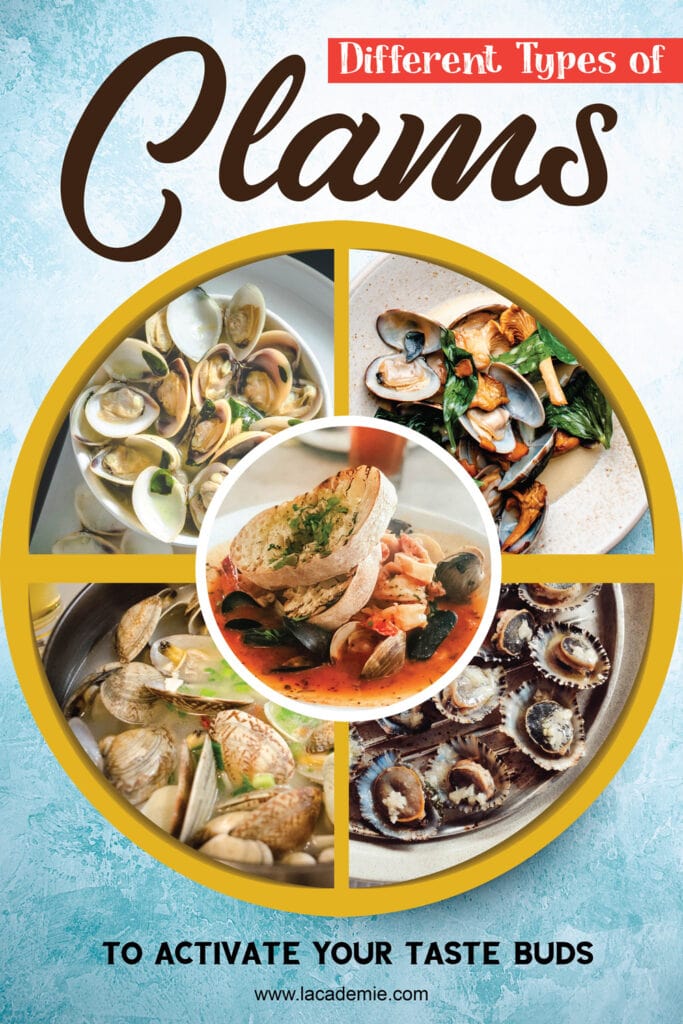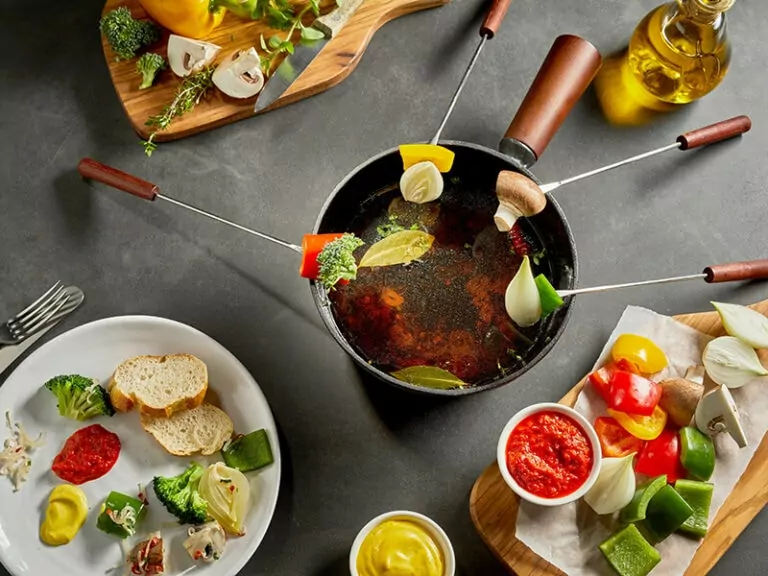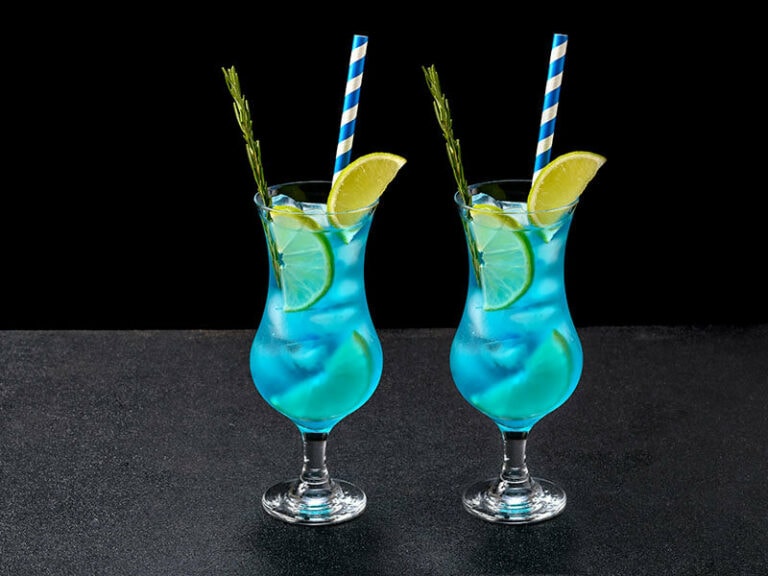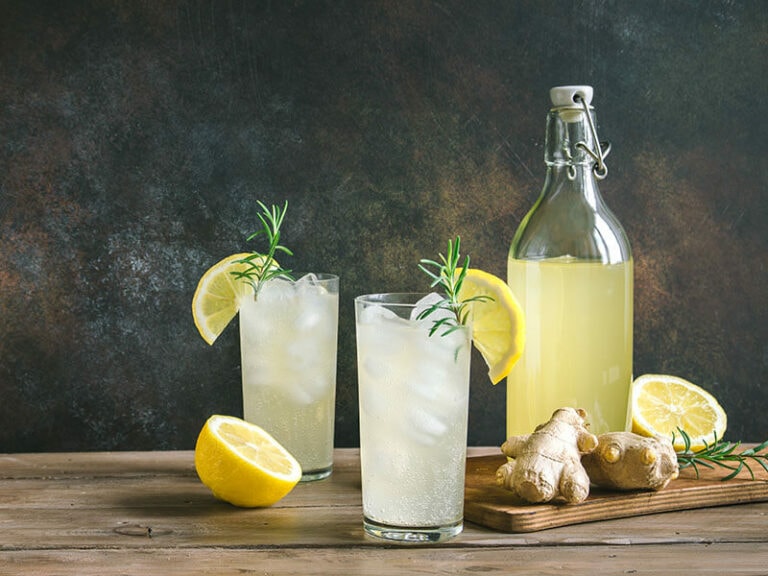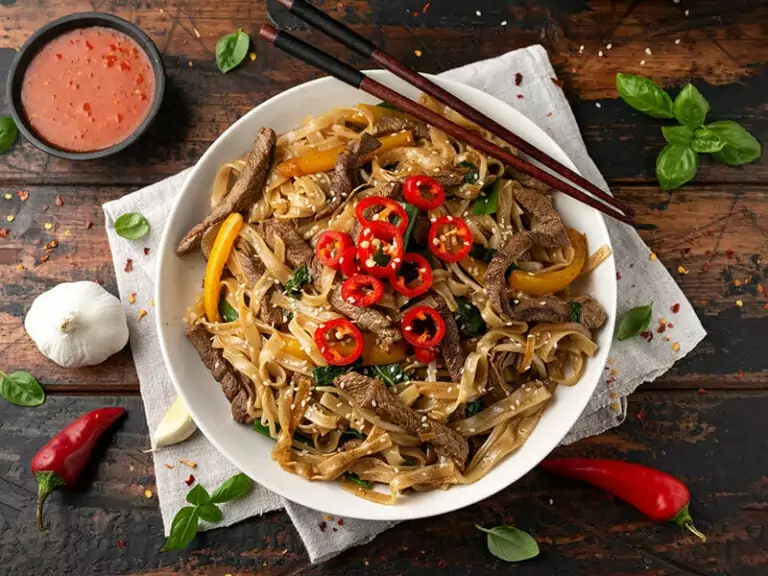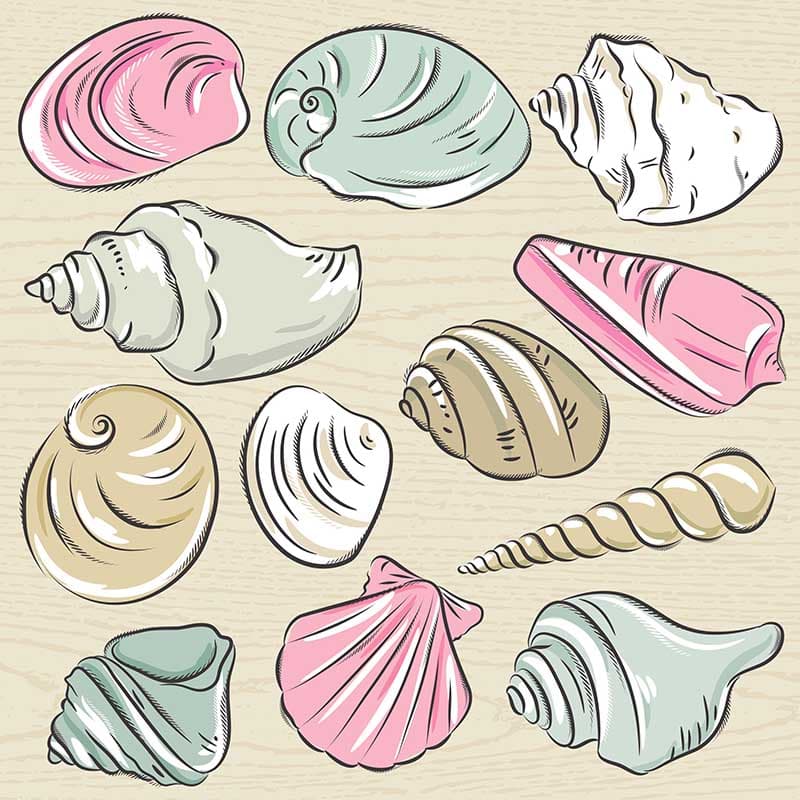
If you are curious about different types of clams, then this article is for you! It will provide you with a lot of information about this gorgeous seafood! I’m sure that you will be surprised by the facts about clams! Let’s dive into this article to find out more!
Clams can also be a great food source for culinary uses! You can use it to make a lot of delectable dishes with various cooking methods such as grilling or making sauces. Learning about types of clams may help you choose the best one for your dish!
What Exactly Are Clams?
Clams are the typical member of the Bivalve family, which have two hinges. People may find clams in both freshwater and saltwater. The clams used in cooking are usually saltwater, while the freshwater clams are generally inedible.
You should know that there are hundreds or thousands of clam varieties in the entire world, and the types are classified based on the depth when they bury themselves in sand or mud and the regions where they live.
15 Different Types Of Clam That You May Not Know About
Let’s come to the most worth-waiting section of this article – the ultimate list of clams! As I’ve said earlier, there are a lot of different clam varieties, but some of them are the most popular and easy to join in your dishes! Let’s see what they are and how you can use them!
7 Typical Types Of Hard Shell Clams For You To Try
Hard Shell clams are the most typical types of clams that you all should know when coming to this list! You should come to these clam types since they are popular and you can use them to make a lot of delicious dishes calling for clams!
1. Quahogs
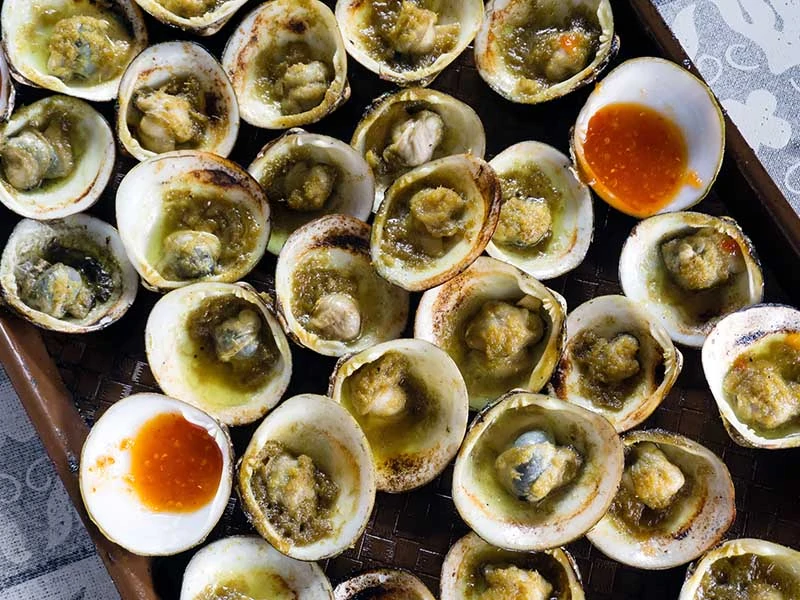
People may find Quahogs on the Eastern seaboard, from Florida to Canada. They will appear mostly in Rhode Island. They are the famous type of clams that you can find in most local stores. However, be aware that store-bought Quahogs are usually farmed clams.
Fresh Quahogs will have their shells closed with some dark-colored rings around. The clam flesh inside will dive from white, cream to gray and brown.
You can stuff Quahogs with many other things like breadcrumbs and bake them as the best dinner dish ever! However, keep in mind that most Quahogs are not suitable for eating raw or steaming.
Let’s grill some Quahogs for a scrumptious meal tonight!
2. Chowder
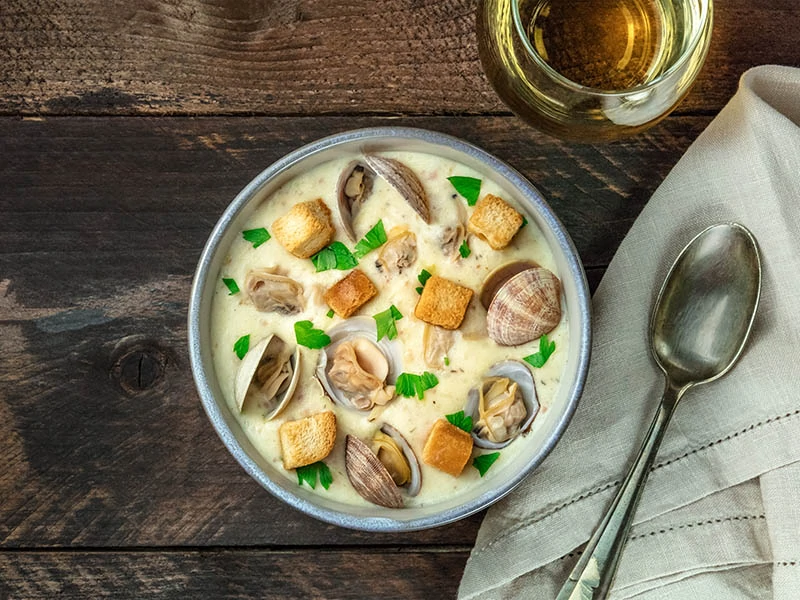
Chowder clams can be one of the largest types of Northern Quahogs. People will harvest this variety when it gets to the oldest age. If your recipe calls for clams, you should totally consider Chowder clams since they can get along well with almost any dish!
Chowder clams are ideal to make chowders, soups, and stews. These clams are best when you chop them and cook them slowly for a delicious chowder dish. In addition, if you intend to serve them raw, just don’t! They are too tough and big for doing so.
Wonder which side dishes to accompany chowder clam? You can always pair it with some bread or crackers for a filling dish. They are truly match-made in heaven!
3. Littleneck
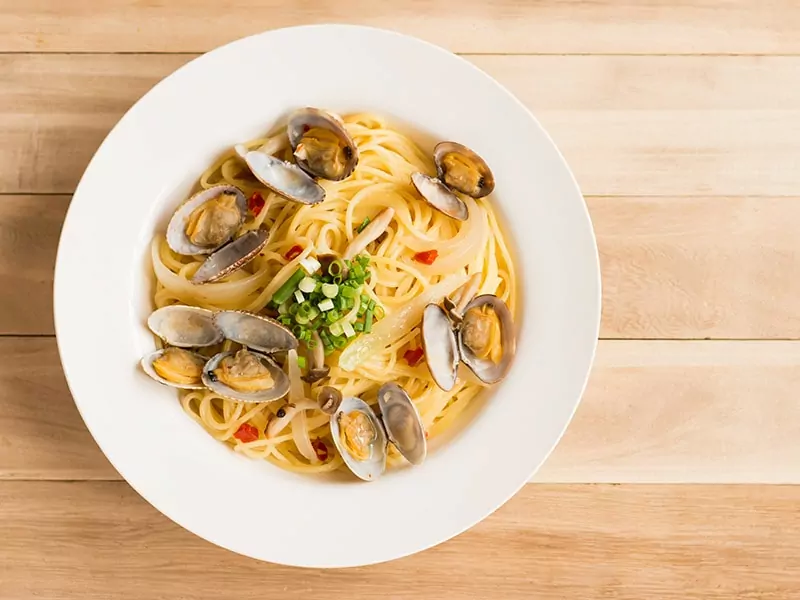
Littleneck is one of the smallest Quahogs existing. It is only about 1 or a half inches large measured at the hinge. Its flesh is super tender and sweet. The name comes from the Little Neck Bay on Long Island, where it is mostly found.
This clam type is ideal for using raw in the half shell. You may also want to grill or steam these clams with potatoes and onions, then serve with pasta for a perfect dinner in the fall!
4. Middlenecks
Middlenecks are also quite large, with two inches in size. They are a bit larger than Littlenecks. It can be a wonderful raw or steamed clam dish with ultra-tender and delectable flesh!
Their size is enough for grilling, so you can choose this type to grill and make the best side dish for a BBQ party! Their flavor when cooked is salty with a sweet aftertaste. You will feel the creamy, rich, and tender texture of them right at the first touch to your tongue!
You may steam these Middlenecks and pair them with spaghetti to make the best Spaghetti alle Vongole dish! Also, add steamed clams to the Spanish seafood paella if you have a craving for seafood!
5. Cherrystones
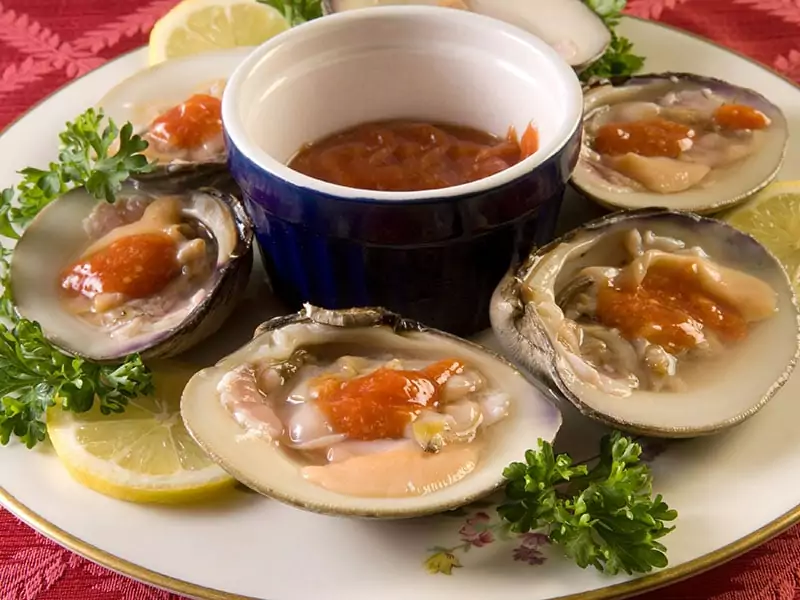
Cherrystones are a typical clam type that is a little bigger than Middlenecks with two and a half inches in the hinge size. They consist of super chewy and tender meat with salty undernotes and a clean, smooth finish.
You can use Cherrystones to make pasta sauce or grill, stuff, or steam them for culinary purposes. You may eat it raw with some lemon juice, too!
Learn how to quickly open Cherrystones clams and cook them properly!
6. Mahogany
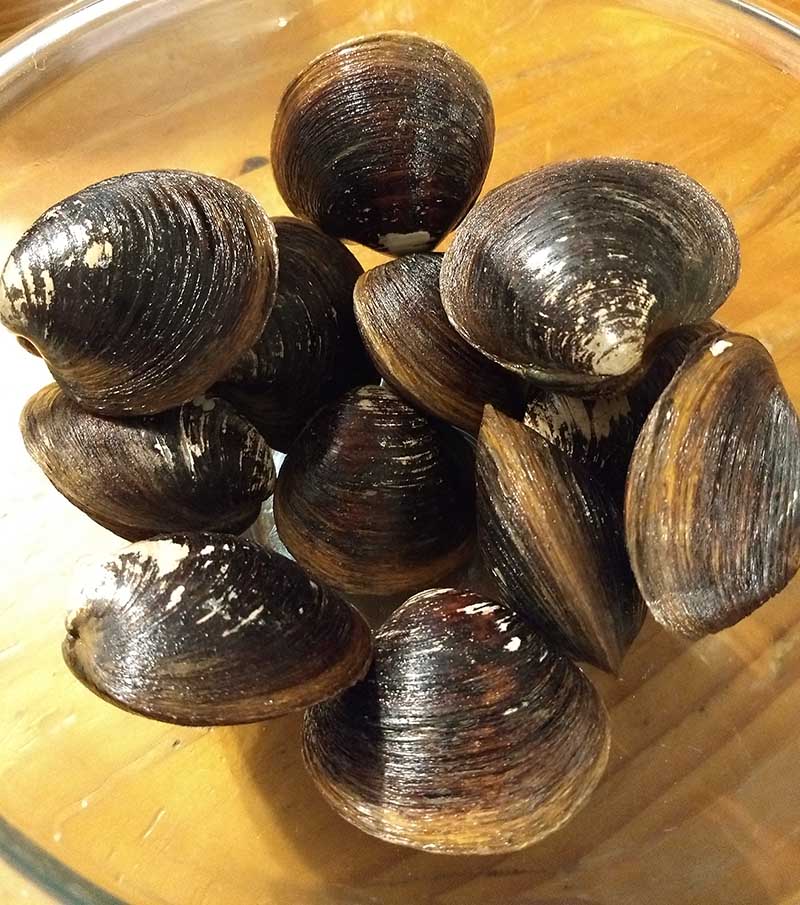
Mahogany clams are the oldest organism in the ocean that can survive more than 200 years! What makes them distinctive from other types and easy to find is that their shells consist of a dark red-brown shade. Their size may be up to three inches!
You may find Mahogany clams in the coastal waters of Maine. Like other types, these clams can also join in pasta, or you can just simply steam and eat it! They can also become an excellent substitute for Cherrystones or Littlenecks.
You can always feel the apparent taste of Mahogany clams in a dish containing ingredients with strong and distinct smells such as tomatoes and bell peppers. Using them in a cioppino or Manhattan-style chowder is also a brilliant idea!
7. Manila
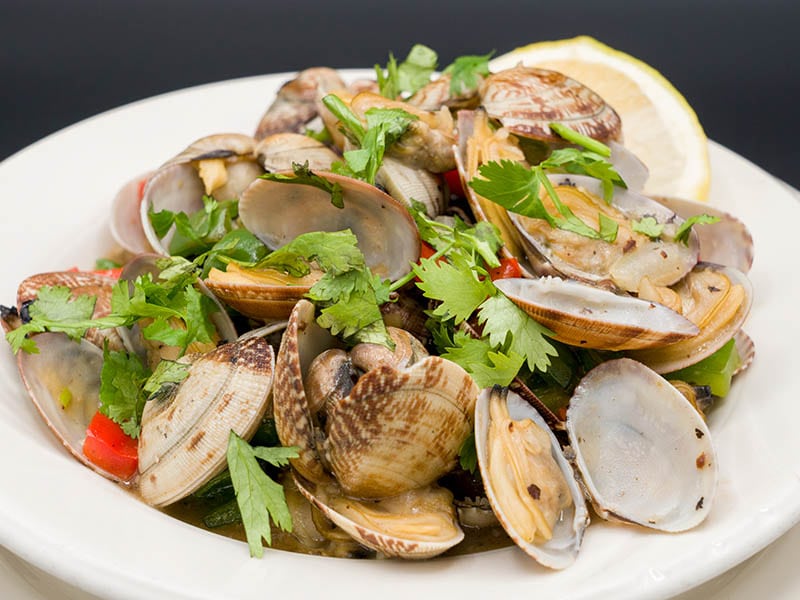
Manila clams originate from the Pacific Ocean. However, people always find them in the Northern coastal region of America. This variety of clams has meatier and less briny flesh than that of Littleneck clams.
Since the shells of Manila clams are thin, they may be cooked faster than other types. You should know that they are quite prized since they have a cleaner and sweeter taste than most other clam types!
Manila clams are famous for their tender texture, which makes them ideal for soups and pasta. They are actually a versatile clam type that you can steam, sautée, bake, poach or apply many other methods to cook them.
2 Distinctive Types Of Razor Clams You Should Taste
Razor clams include a signature shape that is long and thin. They bury themselves into the sand, so you must clean them first when you cook them! There are two primary varieties of Razor clams that you should know. They are divided by the areas where they mostly appear.
Cleaning Razor clams is actually easy with just a few steps!
8. Pacific Razor Clams
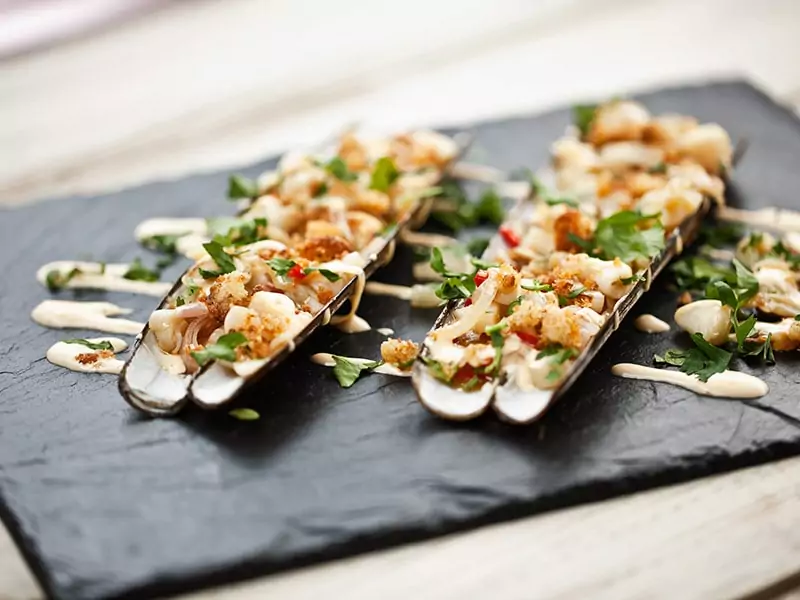
Compared to the other type of Razor clams, Pacific Razor clams are meatier and a bit wider with a clammier taste. They taste best in ceviche and chowder, especially convenient clam chowder in a can! You may also grill, steam, or sautée these clams!
9. Atlantic Razor Clams
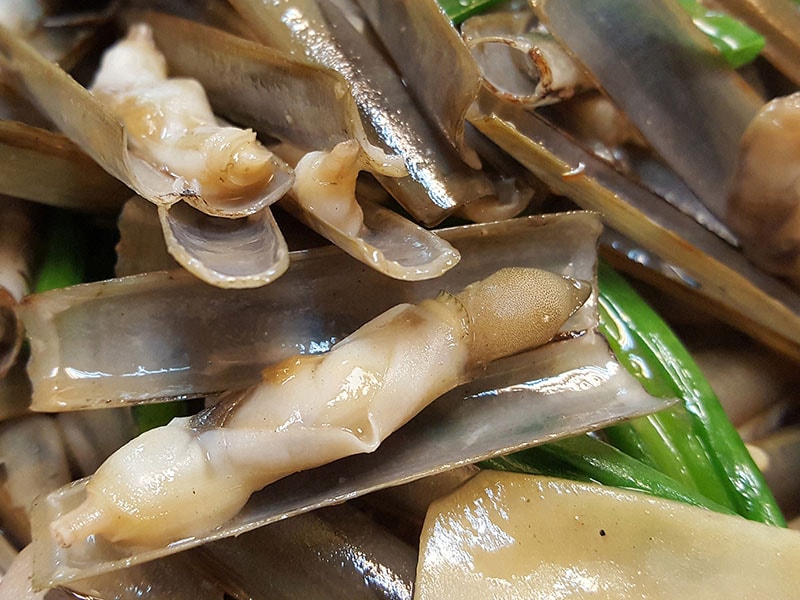
Atlantic Razor clams taste milder and sweeter than Pacific Razor clams. They are also thinner and longer, with up to 8 inches in size. However, they may be less popular than Pacific Razor clams.
You can always steam, grill, sautée Atlantic Razor clams or serve it with a sauce! You should make a light sauce that won’t overpower the flavor of the clams. The early-harvested clams will perfectly pair with ceviche, while the later-harvested ones are more ideal for frying.
6 Amazing Other Types Of Clams You Should Also Know
There are also some types of clams that must be listed in this article for their popularity! They will also be a great source of seafood for your dishes, so I think you definitely should take a look at them and get some information about these extraordinary types of clams!
10. Geoducks
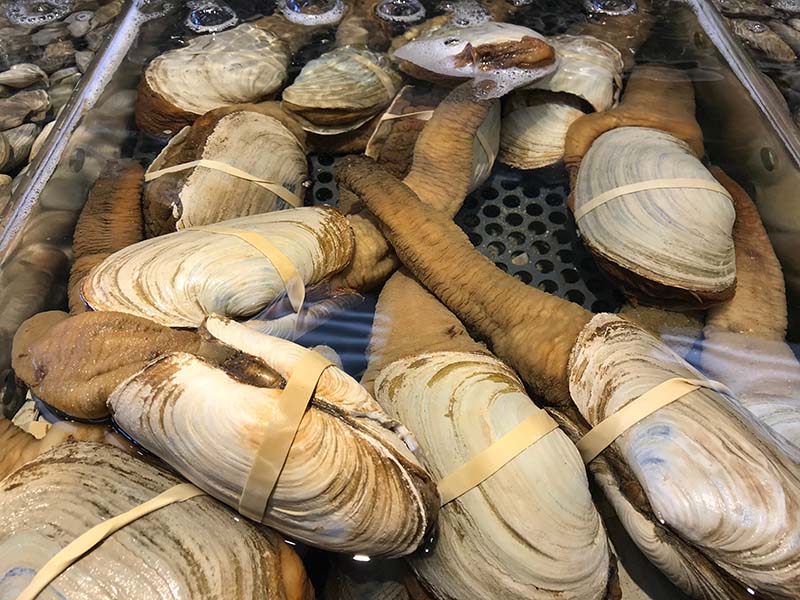
There are two common types of Geoducks, but overall, their meat is salty, chewy, and crunchy. They are giant in size and get the name from their unique appearance, which actually looks like a geoduck in real life!
You may want to fry or make Geoducks into chowder. They will also be a wonderful ingredient in sushi or ceviche with a great texture. The two varieties of Geoducks are Pacific Geoducks and Atlantic Geoducks.
Pacific Geoducks appear on the Pacific coast from Alaska to Baja California. They are the biggest burying clam with an oblong shell. Atlantic Geoducks show up on the Atlantic coast and actually can’t be distinguished from their Pacific sibling.
Here’s basically how you can deal with Geoduck clams!
11. Soft Shell Clams
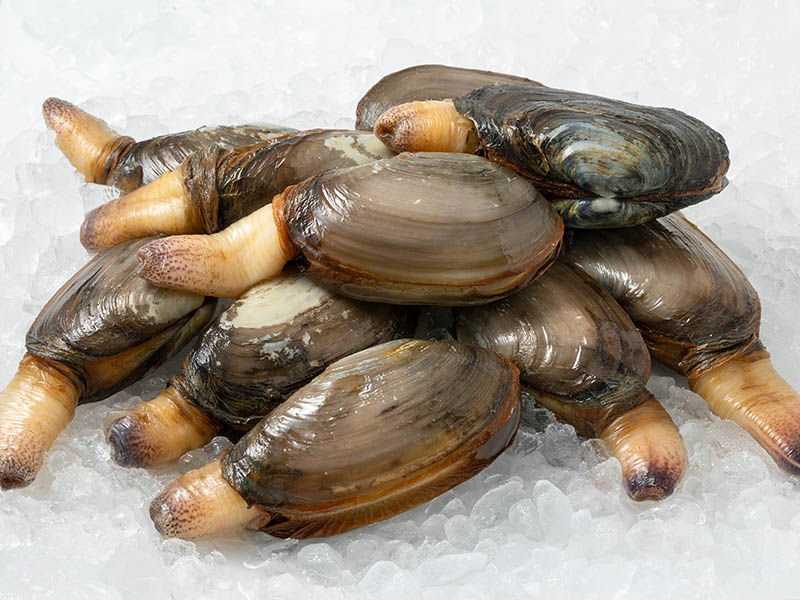
Soft Shell clams consist of super thin and fragile shells that you should handle with ultra care. Their shells are in a light color and oblong shape. They burrow into the sand or mud much deeper than most hard-shell clams and are usually harvested in the wild.
The shell color of Soft Shell clams may change due to the acidity in mud. If they have a darker color, they are tastier! But remember, even though their shells are soft, they are not edible!
These Soft Shell clams are best to steam. People will serve it with steaming liquid and butter. You will eat them by dipping them into the liquid to clean them perfectly before continuing to dip them in butter and eat.
12. Cockles
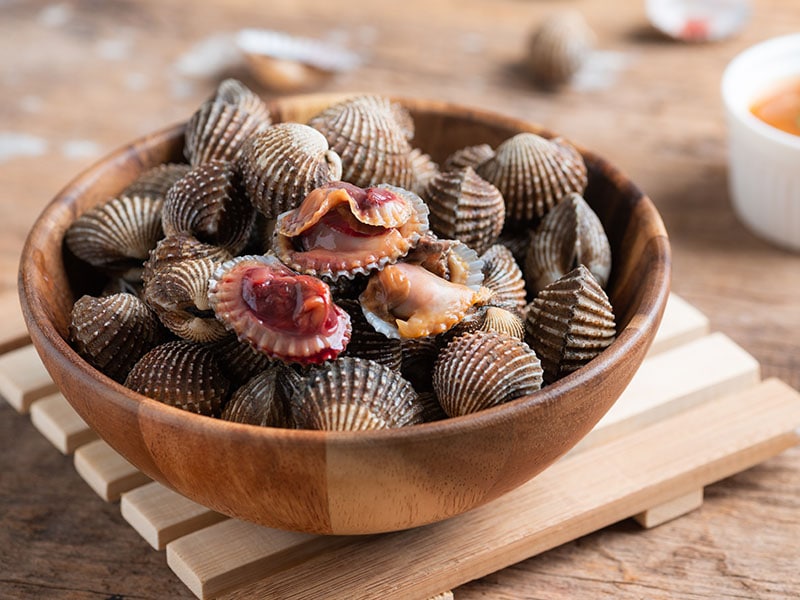
Cockles are not commercially sold in America. You can find them fresh in New England, the West Coast, and the Gulf of Mexico, or in imported cans from Spain to New Zealand. What makes Cockles distinctive from clams is their ridges are from edge to hinge.
The meat of Cockles tastes sweet and delicate, which is suitable to get in a pasta dish or make sauces. If you want a light appetizer for a summer day, consider steaming them and pairing them with some butter and lemon!
You should know that Cockles can be cooked really quickly! So, take them off the heat right when they start to open their mouths.
13. Surf Clams
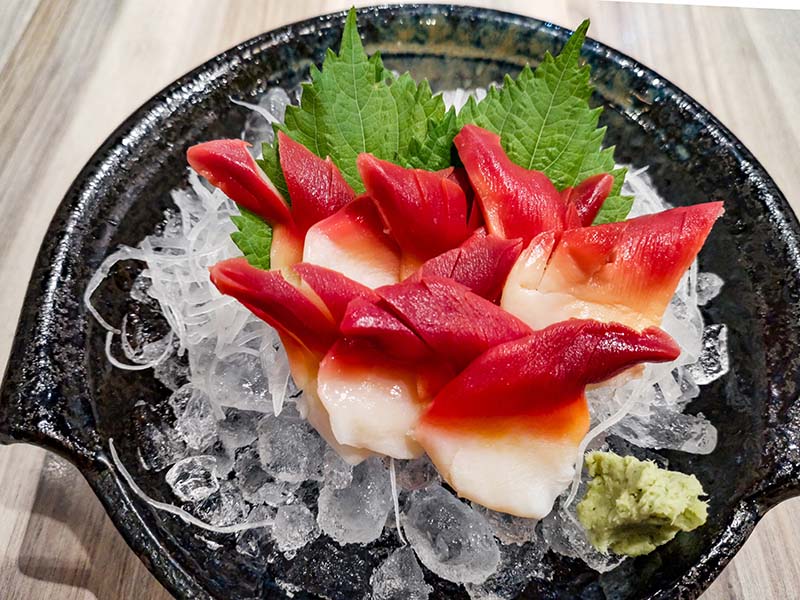
You may know Surf clams under the name Bar clams or Skimmers. They live in the surf on the Atlantic coast. Their flesh is firm and soft with a pretty mild smell. You may want to fry them into clam stripes or turn them into chowder.
Surf clams appear most of the time in cans. If you want to enhance the taste of pasta and soups, you can add the juice in those clam cans! It will bring a delicious flavor from the ocean to your dish!
Let’s see how smooth and juicy the texture of fresh Surf clams is!
14. Atlantic Surf Clams
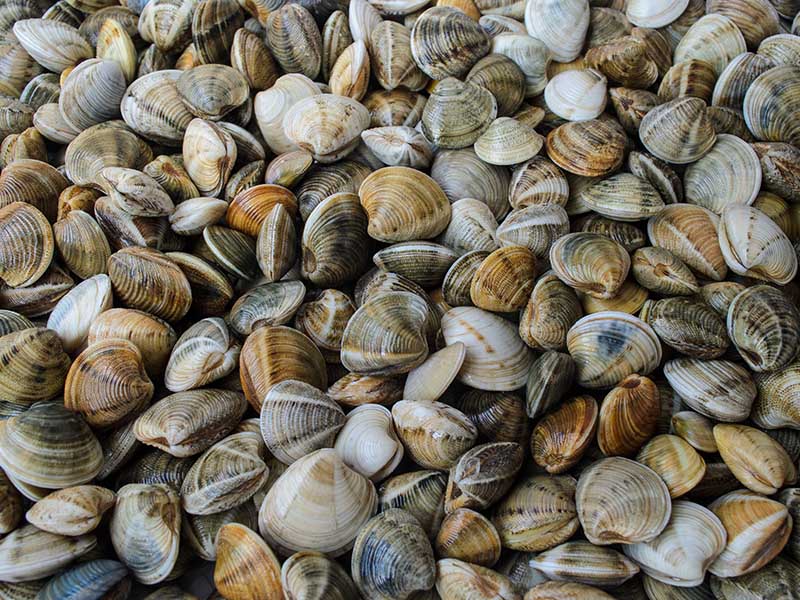
People also use Hen clams to call Atlantic Surf clams. Their shells have a pale shade and are in a special triangular shape. You will mostly find Atlantic Surf clams in frozen or canned form since their shells close tightly and are super hard to open.
Make some soups, stews, and chowders with Atlantic Surf clams, and you’ll be amazed!
15. Washington Clams
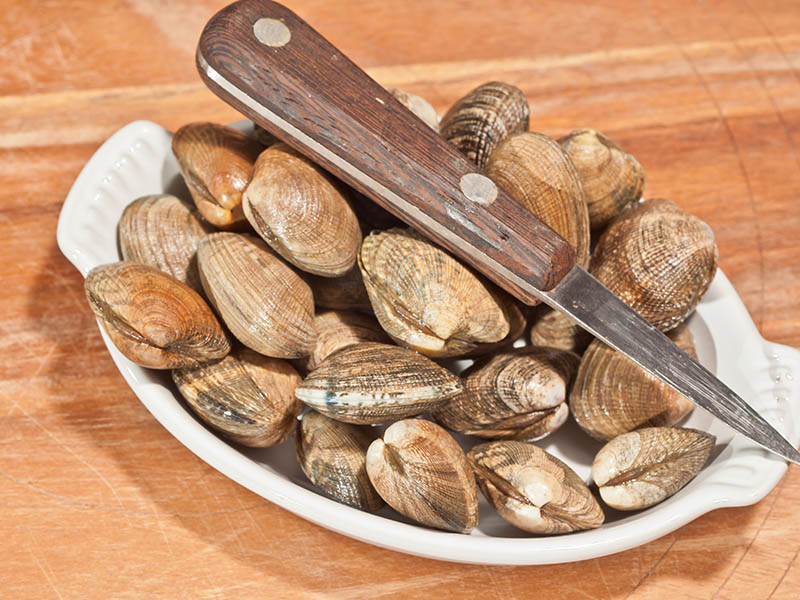
Washington clams are also called Butter clams for their soft and buttery texture that may melt right onto your tongue at first touch! The chefs often use these clams to steam or grill. They also include two types distinguished by regions.
Northern Washington clams are pretty big, with 4 inches in size. These clams appear from Alaska to San Francisco. Southern Washington clams are even larger with up to 7 inches in diameter. Surprisingly, they are mostly found in Mexico, not Washington!
3 Best Recipes With Clams To Serve On Your Special Day
If you are looking for some recipes to cook with your available clams in the kitchen, read this section right away! I’m sure that they will be helpful for you because they are all easy to do with simple ingredients!
Linguine With Clams
Want an elegant yet filling dish of pasta for your special night? Try to make this scrumptious Linguine with Clams! The clam addition and the white wine sauce will make you crave for more! This dish usually uses Littleneck clams, which are an easy type to purchase!
Wow your dear ones with this Italian pasta dish and have a great dinner!
Cape Cod Clam Chowder
This recipe of Cape Cod Clam Chowder may be even simpler than you think! Only with the clams and some basic ingredients or spices, you can totally make this delectable chowder for a lovely summer day! Grab what you have in the kitchen and start the engine!
Baked Stuffed Clams (Stuffies)
Baked Stuffed Clams is actually a simple recipe that you can always make at home on special occasions or even an ordinary day! It will be the best kick-off for your meal or a small party. This dish is a staple of the New England region, especially in Rhode Island state.
As I’ve mentioned before, Quahogs are definitely the go-to clam type for this dish!
Have You Chosen The Best Clams For Your Dinner Tonight?
How do you feel after getting through the list of clams? Have you picked for yourself the best clam varieties for your family’s next meal? Don’t hesitate to leave me some words under the comment box below if you have something to say!
After reading this post, I really hope that you have got yourself something about this seafood variety! Like and share it if you think it is helpful to everyone and may help them in some culinary purposes! See you later in the next articles! Thank you for reading!
